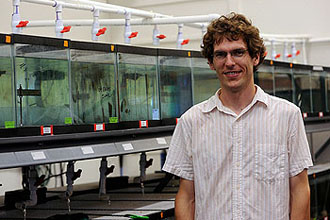Researchers Find Shape-shifting Fish
When rivers are contained by dams, what happens to the river-native species of fish trapped inside? How will a fish that has evolved for the conditions of a fast-flowing river current fare in the still waters of a reservoir? Tulane scientists have found one species of river fish that morphs into a new shape in response to a lake-like environment.

Travis Haas, a doctoral student in ecology and evolutionary biology, is lead author of a study about a species of river fish that morphs into a new shape in response to a lake-like environment. (Photo by Sally Asher)
Among the characteristics of the reservoir-dwelling C. venusta, commonly known as the blacktail shiner, are smaller heads, lower-set eyes, a shorter dorsal fin positioned closer to the head and deeper bodies.
“The public hears that dams do things like prevent salmon from migrating upstream to spawn, or that some species are wiped out entirely within a stream when a dam goes in,” says Travis Haas, lead author of the study and a doctoral student in the Department of Ecology and Evolutionary Biology. “But this is an example of a species that remains in a stream that becomes a lake and changes in response to it.”
Haas, working under the direction of Tulane professors Michael Blum and David Heins, studied the aquatic life in eight pairs of river and reservoir sites in the Mobile River Basin in Alabama. They found that the characteristics of shiners from reservoirs diverged consistently from those in rivers. This indicates that water impoundment constructing dams may be an evolutionary driver acting on aquatic biodiversity.
The study is published in Biology Letters.
Just how long it took for the species to morph is still unknown.
“We don't know if this is something that would take a couple of years or decades,” says Haas, noting that most of the dams in his study sites have been in place for 60 years or less.
To find out, the team will examine the collections of shiners in the Tulane Museum of Natural History that date back to the 1960s.
